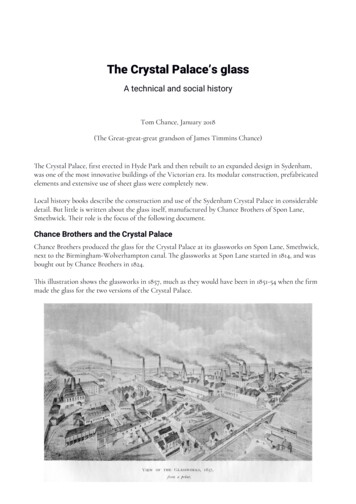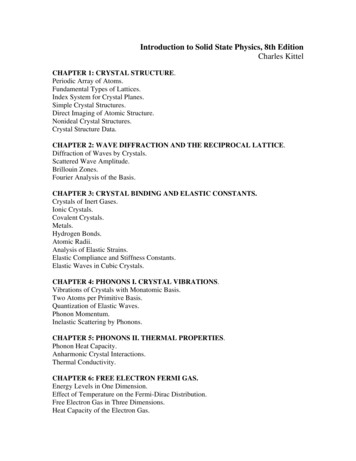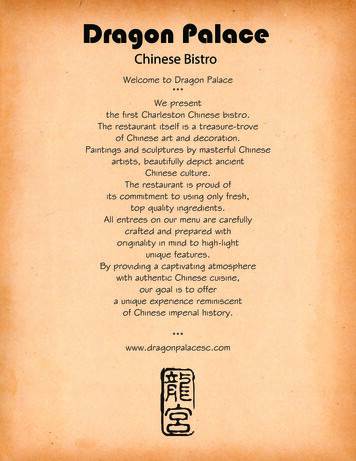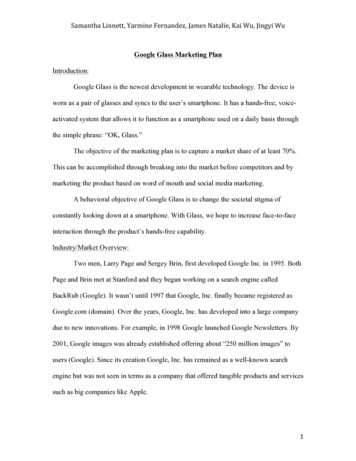
Transcription
The Crystal Palace’s glassA technical and social historyTom Chance, January 2018(The Great-great-great grandson of James Timmins Chance)The Crystal Palace, first erected in Hyde Park and then rebuilt to an expanded design in Sydenham,was one of the most innovative buildings of the Victorian era. Its modular construction, prefabricatedelements and extensive use of sheet glass were completely new.Local history books describe the construction and use of the Sydenham Crystal Palace in considerabledetail. But little is written about the glass itself, manufactured by Chance Brothers of Spon Lane,Smethwick. Their role is the focus of the following document.Chance Brothers and the Crystal PalaceChance Brothers produced the glass for the Crystal Palace at its glassworks on Spon Lane, Smethwick,next to the Birmingham-Wolverhampton canal. The glassworks at Spon Lane started in 1814, and wasbought out by Chance Brothers in 1824.This illustration shows the glassworks in 1857, much as they would have been in 1851-54 when the firmmade the glass for the two versions of the Crystal Palace.
Chance Brothers was one of only two glass manufacturers in England with the capacity to produce thequantity and quality of glass that Paxton required for the Crystal Palace. Chance was chosen over rivalfirm Hartley’s (of Sunderland) owing to their glass being 50% thinner and thus lighter. The sheets ofglass measured 49 by 10 inches (124 by 25 cm), and were one-sixteenth inch (1.55mm) thick. This was aslightweight and large as they could make them without being vulnerable to breakage from hailstorms(Hollister, 1974; Encill, Forthcoming).Joseph Paxton and Robert Lucas Chance already knew each other well. The firm had supplied the 5,201square meters of glass required for Paxton’s Great Conservatory at Chatsworth, and a further order forthe Victoria Regis Lily House. Shortly after Paxton laid his Crystal Palace design before the RoyalCommissioners, he met at the office of Fox and Henderson (the lead contractors) and with RobertLucas Chance to consult on the plans and prepare for detailed estimates and drawings (Williams andChance, 2008).The Building Commission approved Paxton’s plan on the 26th July 1850, and opened the building onthe 1st May 1851. Manufacturing the parts and erecting the building in just 39 weeks was anunprecedented achievement, one we would struggle to reproduce today.The contract required that the glassworks turn out 200 tons of sheet glass more than the usual outputof the works over the period of a few months. At the height of production, in January 1851, some60,000 panes of glass were produced in a fortnight (Hollister, 1974).This image from the 21st December 1950 edition of the Illustrated London News shows blowers workingon the glass:In total, the firm shipped 293,655 panes of glass weighing 400 tons to London (Hollister, 1974; Encill,Forthcoming). The glass covered an area of 92,830 square meters (Encill, Forthcoming), more thanthirteen times the size of the football pitch at Selhurst Park.
Beside the glass, the Palace was supported by 3,300 cast-iron columns and 2,224 principal girders –founded by a company also based in Smethwick - and 24 miles of main gutter; 205 miles of wood sashbar held the glass roof panels in place (Kihlstedt, 1984).Between 1852 and 1854, the entire building was dismantled and reconstructed in Sydenham. Fox andHenderson had to disassemble the building and transport all the materials by horse and cart, a journey12 miles as the crow flies but nearer 20 along busy London roads. They required traction engines tohelp the horses drag the materials up the steep hills (Goode, 1984).There is no consistent or reliable mention in the literature of what happened to the glass from theHyde Park building. Goode suggests that, rather than transport the delicate glass this way, they simplysmashed it, swept it up and sent it back to Chance Brothers to be remade. This seems an extraordinarywaste of money, one not mentioned in any other literature reviewed in this monograph, and theexplanation unlikely given a horse and cart would still have been required to move the glass from thecanals to Sydenham.With the help of the Crystal Palace Museum I found a partial answer. Fox and Henderson, the leadcontractor, sold “80,000 squares” of glass at auction one year after the exhibition, all in small lotspresumably targeted at builders, horticulturalists and other consumer markets.The new palace at Sydenham was far larger than the original, so would anyway have required a largequantity of new glass. Both Edwards and Wyncoll (1992) and Beaver (2001) cite approximate figures forthe quantity of glass – 1,650,000 sq ft (153,000 square meters) weighing 500 tons. The glass would havecovered an area more than 22 times as large as Selhurst Park. However, these quantities seem wrong –unless the glass was much thinner, that area of glass would have weighed over 660 tons. As the newpalace was so much larger, it is likely the tonnage was much greater than 500.Glass, class and migrationMany of the firm’s technical achievements came from the work of James Timmins Chance, newphew ofthe founder Robert Lucas and son of the second of the Chance brothers, William. He studiedMathematics at Cambridge, but was among a mere 3 per cent who at that time went on to work inbusiness, applying his abilities to develop new glass technologies. Prevailing Victorian attitudes amongthe upper classes looked down on business and industry, preferring the church, the law or academia(Williams and Chance, 2008).
James Timmins and his father, William Chance, found themselves caught in two class tensions – thecondescension of the old gentry, and the agitation of the new urban middle and working classes.William had social and political ambitions, and in 1830, as High Bailiff of Birmingham, hosted theDuke of Wellington and Sir Robert Peel on a ‘non-political’ visit to Birmingham. This included a tourof the glassworks and an evening dinner. It turned into a farce.He used this visit – against protocol – to lobby for Birmingham to gain a representative in Parliament.But he did so without the involvement of the Birmingham Political Union, which he had refused tojoin and which was already pressing this case. Crowds of local people gathered outside the dinner,smashing lights – windows were being smashed across Europe in this time of social upheaval andrevolution. While most gathered to protest against the unpopular Duke, some may also have beenprotesting William’s using a local issue for his own advancement. A local satirical newspaper mockedWilliam for his sycophancy – his perpetual bowing ‘as if by instinct’ - and lampooned him as a ‘toadeater, hat-holder and Court-Leet slave’ (Armstrong, 2008).The firm also joined efforts to lobby for the abolition of the excise tax on glass, which William mayhave raised with Wellington and Peel in 1830. This tax, in place for 100 years, was finally repealed bythe government led by Sir Robert Peel in 1845. This halved the cost of finished glass products andencouraged firms like Chance Brothers to scale up production, making quantities such as those usedfor the Crystal Palace both possible and more affordable.In the 1800s migration played an important role in Chance Brothers, as it continues to in the UK’seconomy. If it weren’t for the employment of two Frenchmen, George Bontemps and M. Tabouret, thefirm would never have developed the sheet glass technologies that enabled it to eventually glaze theCrystal Palace.Chance Brothers travelled to the Bontemps glassworks in Choisy-le-Roi in Paris to study his cylinderglass process in 1830, hoping to improve their own methods based on his. Bontemps sent the first waveof French and Belgian migrants to Smethwick in 1832, with skills in blowing, gathering, cutting andflattening. They were paid much higher wages than English workers, and despite the offer of largepayments, declined to teach English workers their techniques. (Hollister, 1974).Bontemps eventually closed his glassworks in 1848, following the revolution in France that year, andcame to work for Chance Brothers in May 1850. Bontemps, Robert Lucas Chance and one of theFrench blowers recruited another 42 French workers in anticipation of the Crystal Palace order(Hollister, 1974).Without these foreign migrant workers it’s doubtful the Crystal Palace could have been glazed, at leastwith materials from a British firm.The science and technology of glassRobert Lucas Chance founded Chance Brothers with three aims – to perfect the quality of glass, tocreate new technologies and scientific achievements, and to define a truly modern glassworks as a civicachievement (Williams and Chance, 2008).These aims fitted well with Paxton’s interests. His experiments with glass buildings for human usefollowed his work on horticultural glasshouses, which were a subject of extensive scientific interestthroughout the nineteenth century. Refinements to the temperature, humidity, solar radiation and air
movement affected the health of plants not suited to the natural climate of Northern Europe(Schoenefeldt, 2008).Scientific research at Kew on the influence of light and solar radiation on tropical plants led tochanges in the development of glass, providing optimal conditions.Correspondence in the Gardener’s Chronicle shows a lively discussion about the effects of irregularitiesin the glass on plants, which some believed could create meniscus lenses which scorched the plants.These irregularities came from the sheet glass process employed by firms including Chance Brothers(Schoenefeldt, 2012b).The glass sheets were produced by first placing a lump of molten glass on the end of a gatherer’s pipe.Blowers then blew down the pipe to expand the glass into a cylinder, alternating between the furnaces,to keep it molten, and aloft, to blow the glass out, testing the diameter against a wooden frame. Thesewere allowed to cool, before drawing a diamond cutting device along the inside of the length of thecylinder to cut a crack. The cylinder was then re-heated so that it fell open by its own weight, andflattened with a block of wood at the end of a handle, and checked for defects – bubbles, variations inthickness, stringy threads or stony droppings from the furnace and blowing process (Hollister, 1974;Armstrong, 2008).When the cylinders of glass were flattened, the shorter circumference on the inside of the cylinder wasstretched, producing an uneven and creased appearance that the flatteners battled against.In 1838, James Timmins Chance filed a patent for a new process of grinding and polishing glass, toimprove the quality and consistency of the sheet glass, and to achieve thicknesses as small as 2mm(Williams and Chance 2008). As mentioned above, Chance Brothers’ ability to produce high qualityglass of this thickness was a key reason they were chosen to glaze the Crystal Palace.Irregularities, and the effects of ventilation, shading and different coloured glasses on the developmentof plants from seed to mature plant, were studied throughout the mid 19th century. Chance Brotherscollaborated with Robert Hunt, who had been commissioned by the Department of Woods andForests to study tinted glass. Botany developed hand in hand with glass (Schoenefeldt, 2012b).
There is a renewed interest in this today, as farmers and botanists look for ways to cultivate greaterquantities of food with fewer material and energy inputs in our cold, wet climate – for example theextensive use of hi-tech glasshouses in the Netherlands.Paxton wasn’t alone in thinking that these principles could be applied to buildings for human use – awide range of surgeons, social and health reformers contemplated the idea. While Paxton thoughtabout large winter parks, John Claudius Loudon dreamt of encapsulating entire villages in glassstructures to control their climates (Schoenefeldt, 2008).Engineering a liveable glasshouseIf plants suffered from poorly designed glasshouses, thousands of visitors in high summer would farelittle better.During the Great Exhibition in Hyde Park, conditions in the Crystal Palace were monitored regularlyby the Royal Sappers, who used 14 thermometers spread throughout the building to update a registerevery two hours. They were able to regulate conditions by manually opening and closing metal louvres,and at the height of the summer by removing panes of glass at the two ends of the building toencourage a through-draught.Such was the public interest that the temperatures were published in various newspapers, as can beseen from the cutting below (Schoenefeldt, 2008 and 2011).After the Great Exhibition in Hyde Park, Paxton set out his vision for reusing the Crystal Palace as ahealthy recreational space for Londoners suffering from unhygienic conditions, pollution and a lack ofdaylight. Schoenefeldt (2008) writes:“Paxton conceived the interior as a type of self-contained biosphere, in which plants and animals,including human beings, mutually participate in the sustenance of an internal carbon dioxide and
oxygen cycle. Animals functioned as the producers of carbon dioxide, which plants need forphotosynthesis, while the plants in turn maintained the oxygen levels of the atmosphere.”Paxton’s strategies for ventilating and cooling the building were modified in the Sydenham version ofthe building. He rejected the idea of using tinted glass and other horticultural strategies, and optedinstead for the use of cross-ventilation and shading.The schematic overleaf, from Schoenefeldt (2011), shows the system he devised. Schoenefeldt’s researchcontains extensive detail on the strategies Paxton experimented with and eventually used in bothversions of the building.An architectural achievement – and inspirationThe Crystal Palace marked a number of great technical achievements.It was one of the first examples of standardised production, with girders, columns, gutters and sashbars all being interchangeable. Its design also made it possible to dismantle the building and reassemble the parts to a different design, supplemented with new parts.It was the first, and probably only, really large free-standing iron-frame building erected in the 19 thcentury, and the first large building with glass curtain walls.In many respects, the building anticipated some of the groundbreaking architecture of the 19 th and 20thcenturies.Most immediately, it inspired a wave of large exhibition buildings, often using similar techniques andmaterials. Dublin held an exhibition in 1852 in a building constructed with wood and glass, and was
followed by many more including New York in 1853, Munich in 1854 and – the concept still admiredalmost 30 years later – Sydney in 1879. The building also probably inspired the development of glasscovered shopping arcades, galleries and department stores (Kihlstedt, 1984).Large glass curtain walls weren’t seen again until Willis Polk's Halladie Building in San Francisco,completed in February 1918. The design of an elegant frame with exceptionally thin walls, designedonly to keep the weather out and let light in, is the essence of Mies van der Rohe’s ‘skin and bones’architecture realised in iconic buildings such as the Seagram Building, completed over 100 years laterin 1958 (Kihlstedt, 1984).Paxton’s experiments with passive cooling and ventilation techniques also prefigured the passivetechnology approach to low energy buildings that only really came back in the 1990s and 2000s.A legacy for glassThe year 1851 wasn’t a landmark for Chance Brothers only for the Crystal Palace.1851 was also the year in which they manufactured their first lighthouse lens (Williams and Chance,2008), a part of the business for which they were to become famed, and for which James TimminsChance was awarded a Baronetcy in 1900.One of the signature exhibits in the British Nave in the Great Exhibition was one such lens, seen justleft of centre in the following image from Dickinson’s Comprehensive Pictures of the Great Exhibition.With the lifting of the excise tax on glass, the development of large manufactories such as Chance’s atSpon Lane, and the advances in technology, glass became a major industry in England.Lighthouses were especially important to the Empire, as well as to the firm. There is an oblique linkagain to Crystal Palace Park, which – with the transmitter station – has a long history ofcommunications technologies. Lighthouses with strong lenses enabled the British to develop safer and
more reliable communication and trade channels across the Empire. Chance Brothers were a majorsupplier of lenses, all starting with the exhibit in 1851.The map overleaf shows the spread of Chance Brothers lighthouse lenses, some of which are stilloperational today.Chance Brothers manufactured other lenses. At the Great Exhibition the firm exhibited a 29 inchdiameter telescope lens. The firm also began making lenses for photography, perhaps through RobertLucas Chance’s friendship with Antoine Claudet, later to become Photographer in Ordinary to QueenVictoria. It was through Claudet that Robert Lucas was introduced to Bontemps (Encill,Forthcoming).There were few photographic exhibits at the 1851 exhibition, and few photographs of the interior. Butby 1854 photography had come of age, and The Crystal Palace Company used this to attract visitors.This was the dawn of a new age of communication, with images of the palace circulated around theworld. By 1858 the palace contained the first large display of photographs to be presented to the publicin England beyond short-term exhibitions.Chance Brothers were the only producers of optical glass, up to 1941. The firm supplied the armedforces during the First World War (Armstrong, 2008), when many were billeted in the Crystal Palaceand the park.One more use of Chance glass that has some contemporary relevance is the Queen Elizabeth Tower,home to the better-known Big Ben bell. The original opal glass in the iconic clock face wasmanufactured by a German firm. But during the Second World War the clock tower and the
Commons Chamber were damaged by a bomb, and Chance Brothers supplied the replacement opalglass for the south dial. Here, you can see workers at the glassworks at Spon Lane laying out the design:In 2017 the clock tower is again being refurbished, though we do not yet know whether any glass willneed to be replaced – and who still makes the opal glass today.The fire, and glass in Crystal Palace Park todayA huge fire destroyed the building on the 30th November 1936. The fire took 500 firemen and 90 fireengines to quell, with another 749 policemen to control the crowds (Edwards and Wyncoll, 1992).Witnesses described "so much molten glass that it looked like a waterfall”, even “like a Niagra Falls ofmolten glass." According to one eye witness "the glass actually caught fire, and when it was really hotthere was a sodium flame and the liquid glass was just pouring down."Mrs Ford from Sydenham described "hot molten glass and metal were flowing down the road, and theadults formed a human chain and passed buckets of water hand to hand in an effort to stem the flow ofhot glass." Another witness recalled people “picking it up and rolling it into balls to keep as souvenirs."
There is no structure using Chance Glass in the park today, and no reconstruction (as with theironwork corner on the hilltop) or memorial (as with the Paxton bust). Save for a one-sentencemention in the museum of R L Chance at Spon Lane, you would not know the firm was ever involved.However, local lore has it that when the Crystal Palace burnt down in 1936, lumps of molten glass wereleft buried in the hilltop. Not everything was snatched for souvenirs! So it is possible that the firmretains an underground presence.As for Chance Brothers, the firm had no further involvement with Crystal Palace Park, to the author’sknowledge. But James Timmins Chance did go on to gift land and lay out West Smethwick Park in1895, around a quarter the size of Crystal Palace Park. In the same year he gave the same sum, 50,000,to set up the Chance School of Engineering at Birmingham University (Armstrong, 2008).Chance Brothers was bought out by Pilkinton Brothers in 1954. They closed the Smethwick glassworksin 1976 and ceased remaining operations in 1981. The factory that produced the Crystal Palace glass isnow a dilapidated building which you can see from the Birmingham-Wolverhampton canal andrailway line.The Chance Glassworks Heritage Trust (www.cgwht.org/) is working to restore the site with newworkspaces, homes and a lighthouse hosting a Chance lens.
ReferencesArmstrong, A. (2008). Victorian Glassworlds: Glass Culture and The Imagination 1830-1880. OxfordUniversity Press.Beaver, P. (2001). The Crystal Palace: A Portrait of Victorian Enterprise. Bognor Regis: Phillimore.Edwards, E. Wyncoll, K. (1992). "The Crystal Palace is on fire!", Memories of the 30th November 1936. London:Pinder Print.Encill, D. (Forthcoming). Chance Reflections, Vol.2: The History and Technology of Chance Brothers, 1824–1981.Hollister, P. (1974). The Glazing of the Crystal Palace. Journal of Glass Studies, 16. 95-110.Kihlstedt, F. (1984). The Crystal Palace. Scientific American, 251-4. 132-143.Leith, I. (2005). Delamotte's Crystal Palace: A Victorian pleasure dome revealed. Swindon: English Heritage.Schoenefeldt, Henrik (2008). The Crystal Palace, environmentally considered. Architectural ResearchQuarterly, 12 (3-4). 283 -294.Schoenefeldt, H. (2011). Adapting Glasshouses for Human Use: Environmental Experimentation inPaxton’s Designs for the 1851 Great Exhibition Building and the Crystal Palace, Sydenham.Architectural History, 54, 233-273.Schoenefeldt, H. (2012a). Creating the right internal climate for the Crystal Palace. Journal ofEngineering History and Heritage, 165. 197-207.Schoenefeldt, H. (2012b). The use of Scientific experimentation in developing the glazing for the PalmHouse at Kew. Construction History, 2011. 19-39.Williams, F., & Chance, T. (2008). Lighthouses: The Race to Illuminate the World. New Holland PublishersLtd.
The Crystal Palace’s glass A technical and social history Tom Chance, January 2018 (The Great-great-great grandson of James Timmins Chance) The Crystal Palace, first erected in Hyde Park and then rebuilt to an expanded design in Sydenham, was one of the most innovative buildings of t










